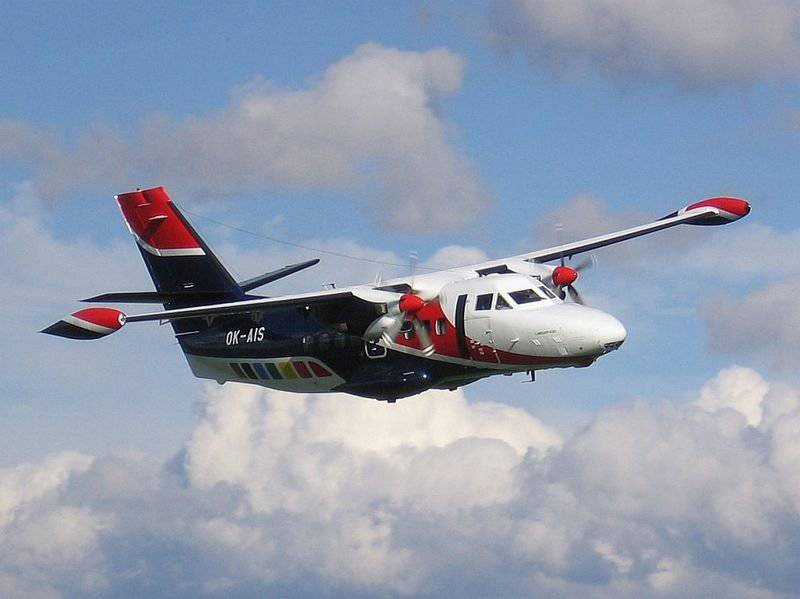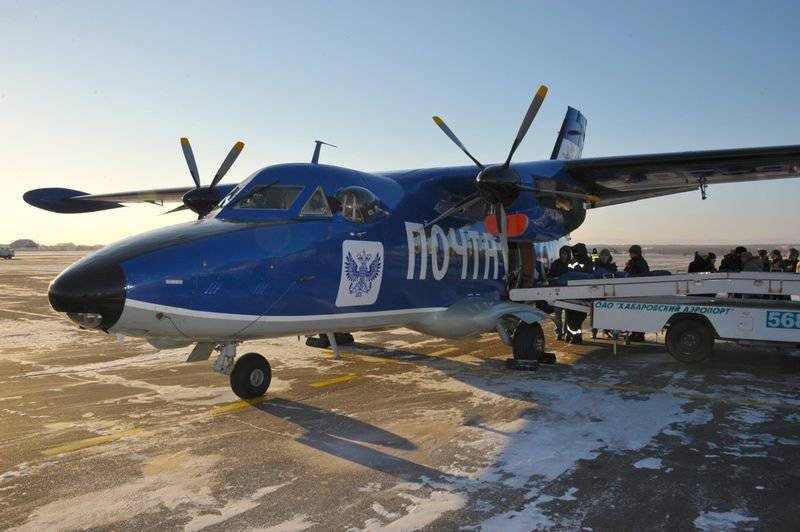L-410 Turbolet will receive Russian "citizenship"
Currently, the main product of the Czech airline is the L-410UVP aircraft. This model is a short-haul aircraft with a short takeoff and landing distance for 19 passengers. The first modification of the aircraft Let L-410 took to the skies in 1969. In the post-war years, the Czech "Turbolet" became the first foreign aircraft that entered the Soviet airlines. On the basis of this machine, a large number of different modifications of transport, military and special purposes were created. In particular, this aircraft is widely used in Russian military and civilian flight schools, where it serves to train future pilots of military transport and long-range aviation.
After the transfer of 51% of the shares of the Czech company to UMMC, the Czech aircraft manufacturer received additional orders for its main product - L-410 UVP-E20. In 2009, after a rather long break, deliveries of aircraft to Russian customers resumed - first to civilian companies, and later to the RF Ministry of Defense. As of 2012, the Russian Air Force was armed with 7 L-410 UVP-E20 aircraft, while the contracts and options concluded involve bringing the fleet of these aircraft to 15 aircraft.

Today, Aircraft Industries supplies the Russian regions with an upgraded version of the aircraft, which is equipped with H-80 turboprop engines, which are produced by the General Electric division in the Czech Republic. According to the UMMC, the installation of these engines significantly improved the performance of the aircraft, increasing, in particular, the flight range from 1420 to 1520 kilometers. Currently, the L-410 aircraft is listed in the parks of the Russian companies KrasAero and Orenburg. The Buryat airline PANH and the government of the Khabarovsk Territory are ready to purchase several aircraft. Earlier, the Ministry of Transport and the Ministry of Industry and Trade of Russia stated that 9- and 19-seat aircraft were needed for the development of the domestic air transportation market, but such modifications were not made in Russia.
Let L-410 "Turbolet" - Czechoslovakian, later Czech, twin-engine universal aircraft designed for operation on local airlines (IL). It is a twin-engine turboprop high-wing aircraft with a single tail. Also known under the names: Let, Let L-410, L-410, Turbolet, Elka, Cheburashka. As of 2012, more than 400 aircraft of this type were operated in the world.
The most common version of the aircraft was the modification of the L-410UVP, in this version, the aircraft had a reduced take-off and landing distance. The abbreviation UVP means “short takeoff and landing”. The aircraft of this modification first took to the skies in 1976. Initially, the machine was equipped with the usual set of aviation equipment of the Soviet-Czechoslovak production. The model differed from its predecessors in the increased size of the wing and vertical tail, elongated fuselage, the use of spoilers and more efficient engines.

It is worth noting that the design and production of small aircraft and air taxis in the countries of the Council for Mutual Economic Assistance (CMEA) bloc was the prerogative of the aviation industry of Czechoslovakia. Czech-made aircraft flew not only in the countries of the socialist camp, but also in Switzerland, Italy, Great Britain, the USA, Australia and other countries of the world. Aero-45, Super Aero-45S and Aero-145 four-seater air taxis, as well as the L-200 Morava, were in particular demand. Therefore, there is nothing surprising in the fact that when the question arose of choosing a small short-haul aircraft for serial production, the choice fell on the Czech L-410, which most fully corresponded to most of the parameters announced in the terms of reference of the State Research Institute of Civil Aviation.
The small passenger aircraft L-410 "Turbolet" was designed by the designers of the company "Let" in 1966-1967, the project was headed by Ladislav Smrchek. It was assumed that this aircraft could be used in a fairly wide temperature range from +50 to -40 degrees Celsius. Czech specialists were guided by the Soviet terms of reference and took into account in advance the difficulties of the climatic conditions for operating the aircraft in the USSR, which was to become the main customer of the aircraft.
In total, by the end of 1978, 100 L-410M / MU aircraft were purchased in the USSR for the Ministry of Civil Aviation. In the Soviet Union, "Turbolets" replaced Antonov's famous "maize" carriers, which transported unpretentious Soviet passengers on the air pits of local airlines. At the same time, it is worth noting that the pilots who were “transferred” from the An-2 to the L-410 perceived the newcomer in two ways. On the one hand, the Czech aircraft had a lot of advantages. Firstly, he had 2 engines, he won 2 times in safety. The plane had a set of modern navigation and radio equipment, a high level of comfort was provided for passengers ... But, on the other hand, for civil aviation pilots fleet An-2 always remained a free "gasoline breadwinner" of their personal Zhiguli and Volga, while the Czech plane flew on kerosene. And in operation, the An-2 was a more unpretentious machine. To be more precise, the flight technical personnel treated the issues of operating the Soviet An-2 much easier. In general, it was considered very prestigious to transfer from the An-2 to the Czech L-410.

In total, since 1969, 1104 L-410 of various models were produced in Czechoslovakia and the Czech Republic, of which 862 aircraft ended up in the USSR. Interestingly, the 1000th Turbolet was produced back in 1990 and transferred to Aeroflot, after which their production volumes were significantly reduced. With the collapse of the CMEA, and subsequently the Soviet Union, the demand for these aircraft dropped sharply. Despite this, Turbosts are still in operation in more than 45 states around the world.
Currently, the Czech Republic is producing a version of the L-410 UVP-E20 aircraft, which can be equipped with analog or digital avionics (at the customer's choice), the TCAS mid-air collision avoidance system and an autopilot. The L-410 UVP-E20 aircraft received the AR IAC certificate.
Flight performance L-410 UPV-E20:
Dimensions: wingspan - 19,48 m., Length - 14,49 m., Height - 5,83 m.
Wing area - 34,86 square. m
The maximum takeoff weight of the aircraft is 6 kg, the empty weight is 600 kg.
Engine type - 2 HPT GE H80-200, power - 2x800 hp
The maximum speed is 395 km / h.
Practical range - 1500 km.
Practical ceiling - 8 000 m.
Crew - 2 person.
Commercial load - 19 passengers or 1800 kg. cargo.
Information sources:
-http: //www.newsru.com/finance/25jul2013/rul410plane.html
-http: //www.airwar.ru/enc/craft/l410.html
-http: //ru.wikipedia.org/wiki/Let_L-410_Turbolet
Information